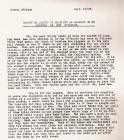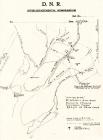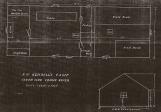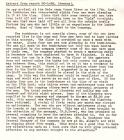1
Logging camps have been an important part of a logger's life. The distance from their homes to the cutting areas was too great to travel everyday so they built shacks and camps to live in. A large number of men engaged in what was known as the "shacking system" and was also referred to as the "truck" or "credit" system. Under these systems, the loggers were paid in advance (early October) with supplies for the logs that were to be brought to the mill owners in the spring.
2
Island Timber Company Shacking Memo
17 September 1937
Bay d'Espoir, NL, Canada

3
Island Timber Company Camp Locations
13 January 1938
Bay d'Espoir, NL, Canada

4
The Island Timber Company set up pulpwood operations in St. Alban's but the main cutting area was in Head of Bay d'Espoir. Island Timber Company had camps but the shacking system was also used by a number of loggers. The company had five camps that employed up to 250 men. One of the camps was sub-contracted to J. W. Kendell of Morrisville. Camp 1 and Camp 5 were located on Main Conne River, Camp 2 was on Southeast Head Bay d'Espoir River, Camp 4 was on Southeast Conne River and Camp 3 was located on Little River.
5
Camp 1 Cookhouse Blueprints
1938
Bay d'Espoir, NL, Canada

6
Camp 5 Bunkhouse Blueprints
1938
Bay d'Espoir, NL, Canada

7
Island Timber Company Bunkhouse Blueprints
1938
Bay d'Espoir, NL, Canada

8
Three of the camps each had a bunkhouse, a cookhouse, stables and storage sheds. The other two camps consisted of jobber cabins which held 4-6 men that cooked for themselves. Jobbers were men who did not work particularly at any one job, sometimes thought of as a "jack of all trades". The cookhouse had three Woodsman ranges and the tables were set with the mugs turned upside down, for this reason mealtime was referred to as a mug up. The bunkhouses were simply designed to house men while they were in the bush. They were not in any way luxurious. The only floor in the bunkhouses was pine planks between the bunks. Each bunkhouse was lined with field bunks that were only 1.6' wide by 6' long. Blankets could be rented for $3.95 a pair and the cost would be refunded when the blankets were returned. Some men rented mattresses for 40˘ per month. Others that did not rent the mattresses slept on the bare bunk or added hay covered with brin. The bunkhouses were heated with tin camp stoves with no latrine (toilet) and only two washbasins for 70 men.
9
Island Timber Company memo on women and children working
4 November 1937

10
Staying at the camps cost $18 per month. Not all loggers relished the idea of staying in company camps for the logging season. They claimed the $18 was a sufficient amount to keep themselves and their family for a month. In this case, they would use the shacking system like years before, pooling together their supplies and building a camp to live in. Many of these men would bring their sons, 12-14 years old, to help with the cutting. The young boys could not stay at company camps because they could not cut enough timber each month to pay their board. Also the company had strict regulations about having boys under the age of 14 and women working in the woods for them.
11
Problems in the bunkhouses
20 January 1938
Bay d'Espoir, NL, Canada

12
There were many problems at these camps. The forest inspector made many reports on how inhabitable these bunkhouses were. Problems such as overcrowding, poorly lit, no floor coverings under bunks and no ventilation, as well as how the men were not being paid fairly. There also had been reports of instances where men had to burn their clothes and blankets because of lice. These reports brought forth the need for regulations and in 1938 renovations were made to the camps according to the Logging Act and the Camp Sanitation Act to improve living conditions. Once these acts were in force, the Commissioner of Natural Resources could give notice of a breach to the company in writing, requesting the company correct the conditions of the complaint. If conditions were not corrected in accordance with such notice the Commissioner had the authority to cancel their permits.
13
Bowater Logging Camp
1945
Bay d'Espoir, NL, Canada

14
In 1942, Bowater Pulp and Paper Company started cutting pulpwood in Bay d'Espoir. Their camps were similar to Island Timber Company but Bowater camps were in better condition. Prior to the early 1950's, log camps were used in practically all Bowater's woods operations. Actual construction of camps was carried out by men employed by contractors. Living conditions vastly improved. Camp layouts differed from one camp to another, but typically they consisted of a barn, a cookhouse, bunkhouses and one or two small utility sheds. Each bunkhouse housed about 20 men. Camp buildings were log styled with moss stuffed or ‘stogged' in between the logs for insulation. The roofs of the camps were covered with felt, not like earlier Island Timber Company camps that were mossed over. In spite of their crude construction, these camp buildings were generally quite comfortable and could be used for several years if necessary.